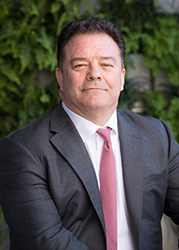Volume 28 | Issue 2
By: Barry Broome, President and CEO, Greater Sacramento Economic Council
Click here to read the complete illustrated article or continue below to read the text article.
For decades, Sacramento was often perceived as a sleepy government town where policy – not next-generation technology – defined its position on the national stage. Yet, it has shed that image, as a series of semiconductor and AI-hardware company investments have recast the region as a strategic node in America’s high-tech supply chain.
For instance, the decision by data storage leader Solidigm to relocate its global headquarters to Rancho Cordova, Calif., gives the region a 230,000-square-foot storage technology research campus and scores of technical job opportunities. Meanwhile, El Dorado Hills-based Blaize just went public in January, becoming 2025’s first pure-play AI-chip IPO. These announcements are just the latest proof that semiconductor startups can comfortably scale in the state capital region, versus having to rely on nearby Silicon Valley.
Growth stories like these are also strong indicators of broader momentum for the region. The region is No. 2 in the Western U.S. and No. 1 in California for job growth, according to a recent report from the Bureau of Labor Statistics. In 2025 alone, Greater Sacramento is projected to experience a 2.7% increase in jobs across its wider tech sector. The region also has 26-times more concentrated semiconductor growth capital and 2.5-times more concentrated clean technology growth capital than the U.S. average, according to an assessment from the Brookings Institution.
Sacramento’s momentum is powered in part by several distinct “engines”: UC Davis, California State University, Sacramento, Sierra College, Los Rios Community College District and – as just one example across its employer base – Intel’s longstanding R&D campus, which catalyzed significant technological change across the region.
For its part, UC Davis joined the SMART USA consortium in December – a $285 million manufacturing institute approved by the U.S. Department of Commerce that is focused on digital-twin design (or, digital models of physical objects) for advanced semiconductors. The partnership puts Davis researchers at the center of broader national efforts to slash the duration of chip design processes.
On the workforce front, Sacramento is doubling down on all levels of innovation. The city’s Innovation Grant program – a collection of efforts to foster innovation and entrepreneurship – recently awarded $500,000 to early-stage tech incubators and accelerators. The funding prioritizes programs that support underrepresented founders, helping to ensure that Sacramento’s startup ecosystem reflects the region’s wealth of diversity. At the same time, local “bootcamps” are rapidly training new talent in cybersecurity and AI, helping employers fill high-demand roles.
High-profile employers are also helping to sustain Sacramento’s impressive tech gains. In fact, Intel’s Folsom campus has been a quiet powerhouse, prototyping processors designed to handle large-scale AI models. That kind of cutting-edge work has created a ripple effect: alumni from Intel have gone on to launch companies like the aforementioned Blaize, innovating in edge AI applications, and Solidigm, the industry-leading data storage solutions company. The result is a tightly connected talent network – where recent grads join anchor companies, startups hire mid-career professionals, and university researchers collaborate across both worlds.
None of this momentum sticks without suitable infrastructure, and Sacramento is meeting the moment. The Sacramento region is home to two community-owned utilities, Sacramento Municipal Utilities District (SMUD) and Roseville Electric, which both offer up to 50% lower cost than California’s investor-owned utilities – crucial for AI companies. SMUD is the sixth largest community-owned electric utility in the U.S. It has committed to reaching zero-carbon emissions in its power supply by 2030 and offers discounted rates for companies with high power needs.
Furthermore, Sacramento’s industrial backbone is keeping pace with its digital ambitions. Thanks to strategically developed, convenient and pad-ready sites, companies can accelerate their site-selection and build-out processes – compressing timelines from years to just months. This offers a clear competitive edge for Sacramento, especially when compared to other hubs where limited land availability and complex regulatory hurdles can stall projects.
In a fast-moving industry where time-to-market can make or break a business, Sacramento’s ability to offer immediate, scalable real estate is helping to attract and retain major players in the semiconductor and AI hardware sectors.
Sacramento’s semiconductor progress saw an even greater spike with the passage of the CHIPS and Science Act in 2022, which aimed to triple U.S. semiconductor production by 2032 (which would equate to the highest growth rate in the world). Regional leaders have used this momentum to secure federal grants and attract additional investment from international companies since that time.
Today, although new tariffs could pose industry- specific challenges, Sacramento’s diversified employer base and infrastructure foundation have made it a highly resilient player in the tech race.
Sacramento’s overall tech diversity is an important strength. With companies pioneering everything from EV chips to edge AI and high-capacity memory, the region isn’t overly dependent on any one element of the sector. This mix helps insulate it from any sudden or sizable policy shifts like those that have been seen under the new U.S. administration.

The usual story about tech hubs revolves around Big Tech giants growing within traditional coastal centers. Sacramento, however, offers a fresh playbook – one driven by growth across multiple fronts and strong, seamless ties to the public sector.
Being near a state capital gives startups and industry leaders a front-row seat to tech policy as it’s being shaped in real time. Instead of reacting to new regulations after the fact, companies can anticipate shifts in areas like climate, mobility and data governance. That kind of proximity turns public policy from a barrier into a blueprint.
As the U.S. moves to broaden its semiconductor base and its AI leadership, Sacramento offers a replicable model of how smaller metros can truly punch above their weight.
While Sacramento has worked diligently to establish its tech-sector credibility, over the coming years, the region will continue scaling with intentionality. The to-do list is clear:
The U.S. is facing a once-in-a-generation challenge: staying ahead in an AI race that depends on chip innovation, software and the changing tides of geopolitics. The real work in this endeavor is happening in cities that turn resources into breakthrough products and high-paying jobs.
Sacramento has become one of those cities. For investors, founders and policymakers, the smart move is to bet that this capital city’s semiconductor surge has only just begun.
Plus, what happens here won’t just shape Sacramento’s future, it could redefine America’s place across the global tech landscape.

About the Author:
Barry Broome serves as the first president and CEO of the Greater Sacramento Economic Council. He is responsible for leading community-driven efforts to attract, grow and scale new businesses; develop advanced industries and guide new job-creation strategies throughout the six-county region. Previously, Broome was the president and CEO of the Greater Phoenix Economic Council, CEO of Southwest Michigan First and led economic development for Toledo, Ohio.
In this episode, I sat down with Beejan Giga, Director | Partner and Caleb Emerson, Senior Results Manager at Carpedia International. We discussed the insights behind their recent Industry Today article, “Thinking Three Moves Ahead” and together we explored how manufacturers can plan more strategically, align with their suppliers, and build the operational discipline needed to support intentional, sustainable growth. It was a conversation packed with practical perspectives on navigating a fast-changing industry landscape.